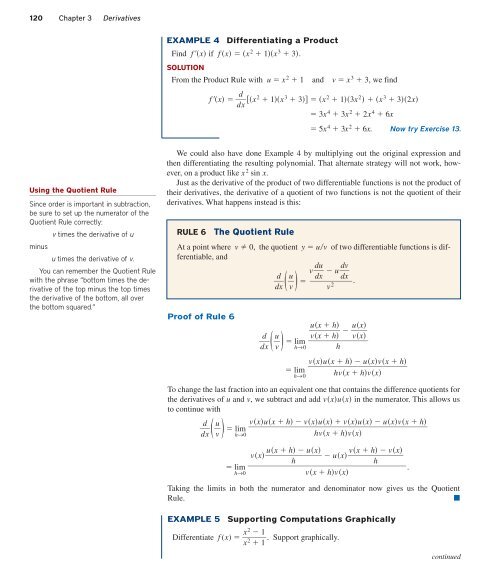5128_Ch03_pp098-184
You also want an ePaper? Increase the reach of your titles
YUMPU automatically turns print PDFs into web optimized ePapers that Google loves.
120 Chapter 3 Derivatives<br />
EXAMPLE 4<br />
Differentiating a Product<br />
Find f x if f x x 2 1x 3 3.<br />
SOLUTION<br />
From the Product Rule with u x 2 1 and v x 3 3, we find<br />
d<br />
f x x d x<br />
2 1x 3 3 x 2 13x 2 x 3 32x<br />
3x 4 3x 2 2x 4 6x<br />
5x 4 3x 2 6x. Now try Exercise 13.<br />
Using the Quotient Rule<br />
Since order is important in subtraction,<br />
be sure to set up the numerator of the<br />
Quotient Rule correctly:<br />
v times the derivative of u<br />
minus<br />
u times the derivative of v.<br />
You can remember the Quotient Rule<br />
with the phrase “bottom times the derivative<br />
of the top minus the top times<br />
the derivative of the bottom, all over<br />
the bottom squared.”<br />
We could also have done Example 4 by multiplying out the original expression and<br />
then differentiating the resulting polynomial. That alternate strategy will not work, however,<br />
on a product like x 2 sin x.<br />
Just as the derivative of the product of two differentiable functions is not the product of<br />
their derivatives, the derivative of a quotient of two functions is not the quotient of their<br />
derivatives. What happens instead is this:<br />
RULE 6<br />
The Quotient Rule<br />
At a point where v 0, the quotient y uv of two differentiable functions is differentiable,<br />
and<br />
v <br />
d<br />
d<br />
( x<br />
u v ) d u<br />
u d <br />
v<br />
dx<br />
dx<br />
.<br />
v 2<br />
Proof of Rule 6<br />
d<br />
d<br />
( x<br />
u v ) lim<br />
h→0<br />
vxux h uxvx h<br />
lim<br />
h→0<br />
hvx hvx<br />
To change the last fraction into an equivalent one that contains the difference quotients for<br />
the derivatives of u and v, we subtract and add vxux in the numerator. This allows us<br />
to continue with<br />
( u v ) lim<br />
d<br />
d<br />
x<br />
h→0<br />
u x<br />
<br />
vx<br />
<br />
h<br />
h<br />
u x<br />
v <br />
x<br />
h<br />
vxux h vxux vxux uxvx h<br />
<br />
hvx hvx<br />
vx ux h ux<br />
ux vx h vx<br />
<br />
h<br />
h<br />
lim<br />
vx hvx<br />
h→0<br />
.<br />
Taking the limits in both the numerator and denominator now gives us the Quotient<br />
Rule.<br />
■<br />
EXAMPLE 5 Supporting Computations Graphically<br />
Differentiate f (x) x x<br />
2<br />
2<br />
1<br />
. Support graphically.<br />
1<br />
continued












